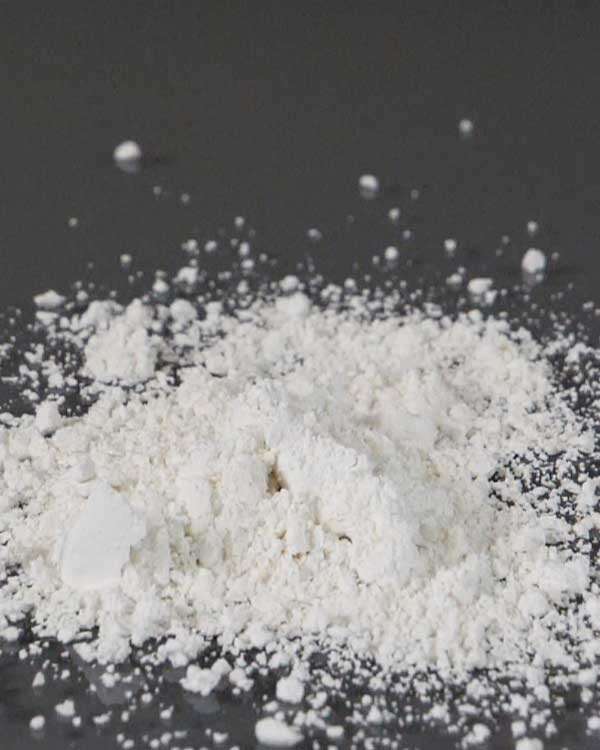Kaolinite, Calcined
Kaolinite is a clay mineral with the chemical composition Al2Si2O5(OH)4. It is a layered silicate mineral, also known as china clay or kaolin.
Source
The name is derived from Gaoling or Kao-Ling ("High Hill") in Jingdezhen, Jiangxi province, China. Kaolinite was first described as a mineral species in 1867 for an occurrence in the Jari River basin of Brazil.
Kaolinite is one of the most common minerals on earth. It is mined, as kaolin, in Brazil, France, United Kingdom, Germany, India, Australia, Korea , the People's Republic of China and the USA.
Kaolinite is a soft, earthy, usually white mineral, produced by the chemical weathering of aluminum silicate minerals like feldspar. In many parts of the world, it is colored pink-orange-red by iron oxide, giving it a distinct rust hue. Lighter concentrations of iron oxide yield white, yellow or light orange colors. Alternating layers of colored clay are sometimes found, as at Providence Canyon State Park in Georgia, USA.
Our white kaolin clay is from deposits in Texas, USA and is heat treated to remove some portion of its hydroxyl (OH) composition. Calcined kaolin is produced by heating ultrafine natural kaolinite to high temperatures in a kiln. The calcination process increases whiteness and hardness and alters the size and shape of the kaolin particles.
Kaolin-type clays undergo a series of transformations upon heating in air at atmospheric pressure. Dehydration begins at 550–600° C to produce disordered metakaolin, Al2Si2O7, but continuous hydroxyl loss (-OH) is observed up to 900° C. Due to disagreement concerning the nature of metakaolin, research has led to general consensus that metakaolin is not a simple mixture of amorphous silica (SiO2) and alumina (Al2O3), but rather a complex amorphous structure that retains some longer-range order (but not strictly crystalline) due to stacking of its hexagonal layers.
Between 100–200° C, clay minerals lose most of their adsorbed water. Between 500–800° C kaolinite becomes calcined by losing water through dehydroxilization. At this temperature range, kaolinite becomes metakaolin, with a two-dimensional order in crystal structure. In order to produce a pozzolan nearly complete dehydroxilization must be reached without overheating. This produces an amorphous, highly pozzolanic state, whereas overheating can cause sintering, to form the dead burnt, nonreactive refractory, called mullite.
Uses
Calcined kaolin clay is used as a functional extender in paint. For example, calcined kaolin clay has proven to be an excellent extender for titanium dioxide (white) pigment in paint. This is because kaolin clay is chemically inert, has a high covering power, gives desirable flow properties and reduces the amount of expensive pigments required. Its hardness also improves physical durability of the paint film and its burnish resistance.
Kaolin clay is also used in grounds, such as for painting and for gilding. The kaolin clay can be used in recipes calling for "pipe clay" and mixed with starch or flour to make a thick cream and applied to wood panel or canvas supports for painting. The ground dries quickly and several very thin layers applied one after another to form a ground typical of 19th century paintings.
| Properties | |
| Median Particle Size (microns): | 1.5 |
| Hegman Fineness: | 5.5 |
| Residue 325 Mesh (%) (ASTM C 325-81 or C 371-77): | 0.05 |
| Specific Gravity (ASTM C-329-75): | 2.58 |
| Bulk Density | |
| Loose (lbs/cu ft): | 23 |
| Compacted (lbs/cu ft): | 33 |
| Mohs Hardness: | 2.0-2.5 |
| Oil Absorption (Gardner-Coleman): | 60 g |
| pH Value (ASTM D 1208-78): | 6.0 |
| Brightness (Colorimeter): | 89 |
| Color: | White |
| Refractive Index: | 1.62 |
| Moisture Content (max. %) (ASTM C 323-56 or C 234-82): | 0.4 |
| Loss on Ignition (%) (ASTM C 323-56): | 0.3 |
| Chemical Analysis | |
| Chemical Formula: | Al2Si2O5(OH)4 |
| Silicon Dioxide (SiO2): | 57.00% |
| Aluminum Oxide (Al2O3): | 39.00% |
| Iron Oxide (Fe2O3): | 1.00% |
| Titanium Dioxide (TiO2): | 0.70% |
| Calcium Oxide (CaO) + Magnesium Oxide (MgO): | 0.35% |
| Potassium Oxide (K2O) + Sodium Oxide (Na2O): | 1.70% |
Health and Safety
WARNING: The product contains crystalline silica-quartz, which can cause silicosis (an occupational lung disease) and lung cancer.
| SKU | 510-15KLN |
|---|---|
| Brand | Rublev Colours |
| Vendor | Natural Pigments |
| Processing Time | Usually ships the next business day. |
Health & Safety: There are no acute or known chronic health hazards with the anticipated use of this product (most chemicals are not thoroughly tested for chronic toxicity). Protect yourself against potentially unknown chronic hazards of this and other chemical products by avoiding ingestion, excessive skin contact, and inhaling spraying mists, sanding dust, and concentrated vapors from heating. Contact us for further information or consult the SDS for more information. Conforms to ASTM D-4236.



